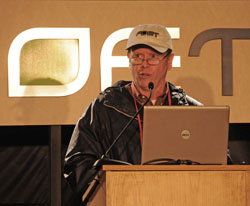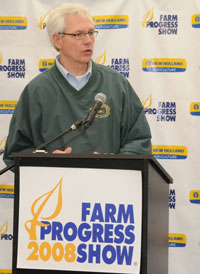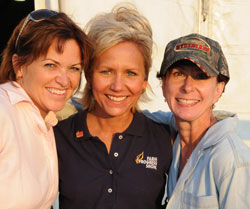 The Director of Project LIBERTY for POET is Jim Sturdevant. He oversees all the activities across the company that are “pulling together to transform this ethanol plant into one of the nation’s first cellulosic ethanol plants.” The plant he’s referring to is POET’s Emmetsburg facility where they held a field day yesterday. He says they intend to replicate what they’re doing with the local plant at their other facilities. Jim was very happy with the turnout at their field day even though the weather was not very cooperative.
The Director of Project LIBERTY for POET is Jim Sturdevant. He oversees all the activities across the company that are “pulling together to transform this ethanol plant into one of the nation’s first cellulosic ethanol plants.” The plant he’s referring to is POET’s Emmetsburg facility where they held a field day yesterday. He says they intend to replicate what they’re doing with the local plant at their other facilities. Jim was very happy with the turnout at their field day even though the weather was not very cooperative.
Jim says they’ve been doing research on corn cob harvesting as well as the economic viability of doing it. He says, “We will not move forward unless this is economical.” Their models show that it will be although there is no pricing on the prototype equipment that was on display at the event.
I think it was interesting to hear him talk about the research into how to store the cobs. It looks like all you have to do is pile them up at the edge of the field for POET to pick them up.
You can listen to my interview with Jim here: poet-liberty-08-sturdevant.mp3
You can also download the interview with this link (mp3).

 He’s a future agriblogger. I think he needs an iPhone and he’s ready to rock and blog!
He’s a future agriblogger. I think he needs an iPhone and he’s ready to rock and blog! Why not? He’s been advocating for family farmers for years right? He’s already started advising the incoming O-man. Read his
Why not? He’s been advocating for family farmers for years right? He’s already started advising the incoming O-man. Read his  I knew it was only a matter of time before USDA’s Office of Communications started podcasting their news feeds. I’ve discussed it with them several times since it makes it so much easier for farm podcasters to get them. It also opens the door to farmers who can now directly subscribe to USDA’s news! That’s as it should be since it’s their tax money helping make the news feeds happen in the first place.
I knew it was only a matter of time before USDA’s Office of Communications started podcasting their news feeds. I’ve discussed it with them several times since it makes it so much easier for farm podcasters to get them. It also opens the door to farmers who can now directly subscribe to USDA’s news! That’s as it should be since it’s their tax money helping make the news feeds happen in the first place. Jeff Broin is CEO of
Jeff Broin is CEO of  I never get tired of taking sunset pictures. This is one from the highway just east of Des Moines, IA on my way to Emmetsburg this evening. You can see that the clouds were rolling in and they’re here now. It’s raining and thundering and lightning outside.
I never get tired of taking sunset pictures. This is one from the highway just east of Des Moines, IA on my way to Emmetsburg this evening. You can see that the clouds were rolling in and they’re here now. It’s raining and thundering and lightning outside. As I was driving into Emmetsburg I saw this plant off in the distance.
As I was driving into Emmetsburg I saw this plant off in the distance.  U.S. Agriculture Secretary Ed Schafer today announced the resignation, effective December 1, 2008, of Agriculture Under Secretary for Rural Development Thomas C. Dorr.
U.S. Agriculture Secretary Ed Schafer today announced the resignation, effective December 1, 2008, of Agriculture Under Secretary for Rural Development Thomas C. Dorr.  I think the last time I was in Emmetsburg, IA it was to visit with a local radio station for the Brownfield Network. It’s been a while. Well, that’s where I’m headed to attend tomorrow’s
I think the last time I was in Emmetsburg, IA it was to visit with a local radio station for the Brownfield Network. It’s been a while. Well, that’s where I’m headed to attend tomorrow’s  Vicki Henrickson is pictured on the right here along with Rhonda Ludwig and Anita Vanderwert at this year’s Farm Progress Show. It’s the first picture I found in the ZimmComm archives when looking for one to use with this news from
Vicki Henrickson is pictured on the right here along with Rhonda Ludwig and Anita Vanderwert at this year’s Farm Progress Show. It’s the first picture I found in the ZimmComm archives when looking for one to use with this news from  I thought this image of corn microphones from the
I thought this image of corn microphones from the